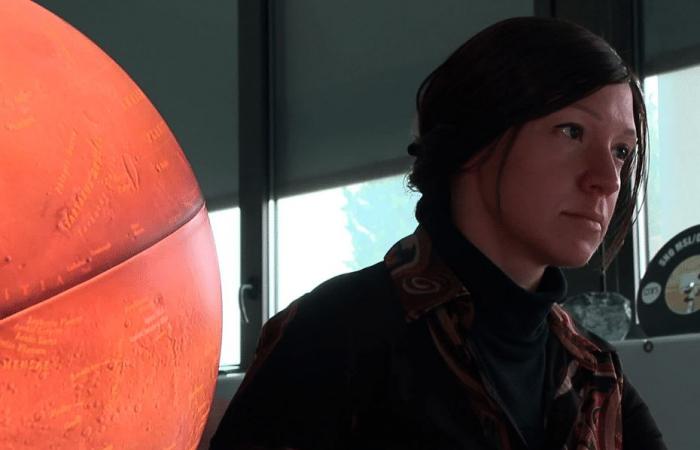
Anna Gau-Galofré is a researcher at the planetology and geosciences laboratory in Nantes. She has just obtained a European grant of 1.4 million euros for her work on the canyons of the planet Mars. According to her, traces of life on Mars could still be found.
The essentials of the day: our exclusive selection
Every day, our editorial team reserves the best regional news for you. A selection just for you, to stay in touch with your regions.
France Télévisions uses your email address to send you the newsletter “Today’s essentials: our exclusive selection”. You can unsubscribe at any time via the link at the bottom of this newsletter. Our privacy policy
Mars, the red planet is far from having revealed all its secrets.
Every day, the Nantes laboratory receives photos of its surface, transmitted by the European Space Agency, in particular photos of its gigantic geological formations.
Anna Gau-Galofré is a researcher at the planetology and geosciences laboratory in Nantes. Its mission: to study the surfaces of Mars and try to detect if traces of life are still alive.
Canyons as clues
The researcher has just obtained a European grant of 1.4 million euros for her latest work on the canyons of the planet Mars.
Because according to her, traces of life on Mars could still be found.
“I am studying the largest canyon in the solar system, which is also the largest canyon on Mars. It measures 2,500 km in length and 300 km in width. Its structure is truly enormous. We don’t have anything like that on Earth. In my study, I wonder what the origin of this mega canyon could be.”
Researchers from Nantes are studying this canyon, the largest in the solar system, and the largest canyon on the planet Mars.
•
© Image CNRS
Its main hypothesis is as follows: this Martian mega-canyon would have been formed by a mega-flood. “In my opinion, there was an ice cap in that region. And 3 billion years ago, it was this mega-ice sheet that formed the mega-canyon.”
AnaI Anna Gau-Galofré draws on images from a European Special Agency probe, in orbit around Mars.
In her laboratory in Nantes, every two months, she sends all the commands to the probe’s camera. The latter takes photos in different regions of Mars.
I study the surfaces of the planet Mars. My main interest is glaciology
Anna Grau-GalofréCNRS Researcher – Nantes Planetology and Geosciences Laboratory
“When I look at the photo of Mars like that, I’m mainly working by looking at the geological evidence that there was ice on the surface of Mars. This is important for many things. For example, the presence of the Water is a possible presence of life in the past. Sure, we’ve never found life on Mars, but we’re still looking.”
The glacier is a very interesting place to look for life
Anna Grau-GalofréCNRS Researcher – Nantes Planetology and Geosciences Laboratory
So the first hypothesis, the main hypothesis, is that the canyon was formed during a catastrophic flood.
“You imagine, for example, that there was a large water reservoir in this part, at the end of the canyon. There was a lake, or something with a lot of water. And all that water was released at once. This may have caused a large flood that flowed 2500 km to the end of the canyon.”
“But my project, my hypothesis, is a little different. If we think that there is a glacier that was placed in this region, therefore a large ice cap, it could have allowed the formation of a mega-glacier.
Mars is a planet that is far from the Sun, which has a lot of water on its surface. So actually, the formation of ice caps on Mars is easy and plausible
Anna Grau-GalofréCNRS Researcher – Nantes Planetology and Geosciences Laboratory
See our team’s report:
duration of video: 00h01mn52s
Anna Gau-Galofré is a researcher at the planetology and geosciences laboratory in Nantes. She has just obtained a European grant of 1.4 million euros for her work on the canyons of the planet Mars. According to her, traces of life on Mars could perhaps still be found. Team: Fabienne Even, Guillaume Perrot, William Sabas and Sophie Boismain Speakers: – Anna Grau-Galofré CNRS Researcher – Nantes Planetology and Geosciences Laboratory – CNRS Images (from the start of the subject and at 14″) – Sam Anderson and #Haughton2024 (at 53″)
•
©France 3 Pays de la Loire
And she continues: “Because the glacier and the ice caps are things that are habitable. There are a lot of bacteria living quietly inside the ice.”
One could envision finding bacteria and other life forms that never formed on the surface of Mars that might still be alive. Because if there were glaciers, there could be a living body, perhaps, inside these glaciers.
Anna Grau-GalofréCNRS Researcher – Nantes Planetology and Geosciences Laboratory
The researcher still remains lucid: ‘It is imaginable to find life on Mars, yes, but it remains very complicated. Because there are regions on the surface of Mars where we don’t go. We never go to the ice deposits which are located in a latitude of 40 degrees North. So there are ice deposits on the surface of Mars that are in places where maybe there’s a temperature that maybe would still be habitable.”
Pour To test these hypotheses, the researcher conducts field research, such as this summer on the west coast of Greenland.
“During the last ice age, there was a large ice sheet that was part of the Greenland ice sheet. So here we ask ourselves the question, what happens when there is a glacier and a crater that interact? What is happening to the landscape? How does this affect landscape erosion? How can we see the rock and interpret that there was ice there?”
By analogy, the scientist compares and analyzes all the avenues.
“The idea is to take everything we see on Earth, from these mega-glaciers, to come back to Mars and try to interpret the geology of the rock that we see on the surface of Mars. We are still on this expedition, this interest in finding forms of life outside of Earth.
The European Stock Exchange will allow the researcher and her team to continue these investigations over the next 5 years.
Find us on our networks and on our site france.tv





